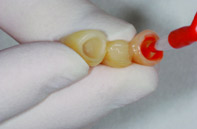Acid Etching of Ceramic Before Bonding

Acid etching ceramic restorations prior to bonding is essential in order to create the appropriate surface structure needed to maximize retention of the resin cement.
Frequently the restoration is etched in the laboratory. If the restoration is etched in the laboratory, do not re-etch in the office with 5% HF. Etching a second time is contraindicated. If the ceramic appears white and chalky, it is over etched. When in-office etching is needed, the following protocol should be used to ensure success.
- Lithium disilicate (e.max): 20 second etch with 5% HF.
- Leucite ceramic (Empress Esthetic, Authentic, etc.): 60 second etch with 5% HF.
- Feldspathic ceramic (d.SIGN, Ceramco, etc.): 120 second etch with 9% HF.
- Zirconia (Lava, Wieland, etc.): Do not etch.
After etching, place the restoration in water and ultrasonically clean for five minutes. Air-dry with oil-free air. Apply silane to the intaglio surface for 60 seconds and then air-dry. Avoid getting silane on the outer aspect of the restoration as it will make resin cement stick to the polished outer surface, increasing the difficulty removing it during clean-up after bonding to the tooth.
If the restoration is tried in intraorally and the intaglio surface is contaminated with saliva, blood, try-in paste, etc., it must be cleaned before final bonding. Use 37% PhO4 for 60 seconds, followed by rinsing and placing in water and ultrasonic for five minutes.
If an alternate method is desired, Ivoclar recently introduced Ivoclean, which has been specifically developed to clean ceramic after intraoral try-in procedures. The intaglio surface is coated with Ivoclean for 20 seconds, rinsed thoroughly with water, and dried with oil-free air.
SPEAR campus
Hands-On Learning in Spear Workshops
With enhanced safety and sterilization measures in place, the Spear Campus is now reopened for hands-on clinical CE workshops. As you consider a trip to Scottsdale, please visit our campus page for more details, including information on instructors, CE curricula and dates that will work for your schedule.

By: Robert Winter
Date: August 15, 2012
Featured Digest articles
Insights and advice from Spear Faculty and industry experts


